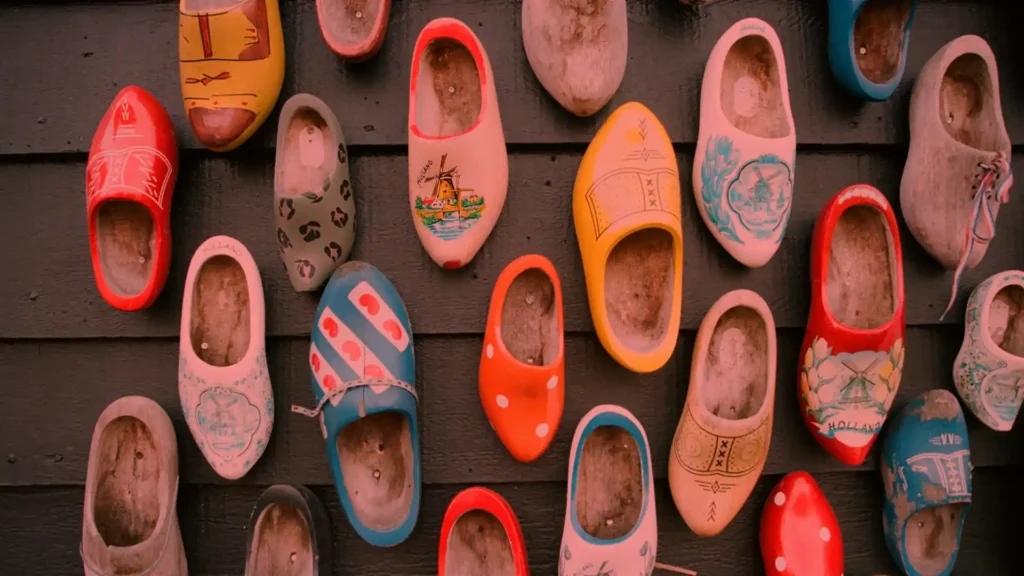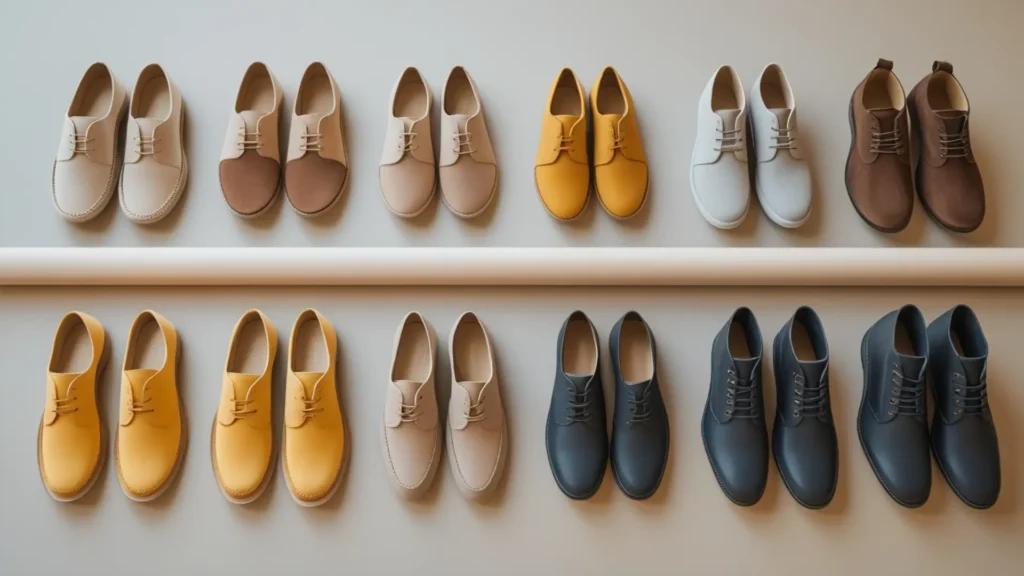Clogs, or klompen in Dutch, are more than just footwear. They are a symbol of Dutch heritage, practicality, and resilience.
For centuries, clogs have shaped the Netherlands’ identity. This article explores the rich history of clogs in Dutch culture.
The Origins of Clogs
Clogs have deep roots in Dutch history. The earliest evidence of wooden shoes in Europe comes from the Middle Ages.
In the Netherlands, archaeologists uncovered wooden footwear in peat bogs dating to the 13th century. These early clogs were simple. They were carved from a single piece of wood, often alder, willow, or poplar. These woods were soft, lightweight, and easy to shape.
A study by the University of Amsterdam analyzed medieval clogs. It found that peasants and farmers wore them widely. Clogs were affordable and practical. They protected feet from wet, muddy fields.
The Netherlands, with much of its land below sea level, had soggy terrain. Clogs kept feet dry and safe from sharp objects. The study also noted that clogs were durable. A single pair could last years with proper care.
By the 15th century, clogs became more common. Historical records from Utrecht show that clog makers, known as klompenmakers, formed guilds.
These guilds regulated the trade. They set standards for quality and craftsmanship. A well-made clog was sturdy and comfortable. The craft of clog-making grew into a respected profession. By 1500, klompenmakers were active in Amsterdam, Rotterdam, and Gouda.
Clogs in Daily Life in The Netherlands
Clogs were essential for Dutch workers. Farmers wore them in fields. Fishermen used them on wet docks. Factory workers in the 19th century relied on clogs to protect their feet from heavy machinery.
A report by the Dutch Historical Society highlights why clogs were ideal. The thick wood shielded feet from cold, water, and workplace hazards. Unlike leather shoes, clogs didn’t rot in damp conditions.
Clogs were also cost-effective. Leather shoes were expensive and required skilled cobblers.
Clogs, however, were simple to produce. A skilled klompenmaker could carve a pair in a few hours. A 2010 study by the Netherlands Open Air Museum found that in the 1800s, a pair of clogs cost about one-tenth the price of leather shoes.
This made them accessible to the working class.
Women embraced clogs too. Housewives wore them for chores like gardening, cleaning, or milking cows. Some clogs were decorated with carvings or paint. These designs showed personal style or family pride. A 2003 exhibit at the Zuiderzee Museum showcased women’s clogs with floral patterns or geometric shapes. These ornate clogs were often worn for special occasions, such as weddings, baptisms, or church services.
Children also wore clogs. They were sturdy and outlasted cloth or leather shoes. Parents could hand clogs down to younger siblings, saving money for poor families.
A 2018 book, Dutch Material Culture, notes that clogs were a staple in rural households until the early 20th century. Some families even repaired clogs by patching them with wood or metal, extending their lifespan.
Clogs varied by region. In Friesland, clogs had pointed toes. In Brabant, they were wider and rounded. These differences reflected local traditions and needs.
A study by the Dutch Ethnographic Institute found over 50 regional clog styles. Each style was adapted to the local environment, such as sandy soils or clay-heavy fields.
Cultural Significance of Clogs in Dutch History
Clogs became a powerful symbol of Dutch identity. During the Dutch Golden Age in the 17th century, the Netherlands was a global trade power.
Dutch painters Jan Steen and Pieter Bruegel depicted clogs in their work. These paintings showed everyday life, with farmers, maids, and villagers wearing klompen. A analysis by the Rijksmuseum found that clogs appeared in over 30% of Dutch genre paintings from this period. They represented hard work, humility, and connection to the land.
Clogs also appeared in Dutch folklore. Stories, proverbs, and songs celebrated klompen. A traditional children’s song, “In de Klompen,” describes the sound of clogs clattering on streets. According to a education report, this song is still taught in some Dutch primary schools.
It connects young generations to their heritage. Proverbs like “Met klompen aan kun je niet sluipen” (“You can’t sneak with clogs on”) emphasized honesty and straightforwardness, values tied to Dutch culture.
In the 19th century, clogs became a tourist attraction. Foreign visitors saw clogs as exotic. They purchased carved or painted clogs as souvenirs. A tourism study by the University of Leiden found that clogs were among the top-selling Dutch keepsakes.
Markets in Amsterdam, Volendam, and Marken sold thousands of pairs annually. Some clogs were purely decorative, too small or fragile to wear.
Clogs played a role in festivals too. In rural areas, communities held “klompendansen,” or clog dances. Dancers wore heavy clogs and performed rhythmic steps on wooden stages. A article in Folk Culture Journal describes how clog dancing showcased skill and community pride.
Dancers competed to create the loudest or most intricate rhythms. Some villages, like Staphorst, still host clog dance events today.
Clogs also appeared in religious and social rituals. In some regions, brides wore white-painted clogs during weddings. A study by the Dutch Folklore Society notes that these clogs symbolized purity and good fortune. In fishing villages, clogs were sometimes placed outside homes to ward off bad luck. These traditions tied clogs to deeper cultural meanings.
Clogs During Industrialization
The Industrial Revolution transformed clog production. In the late 19th century, machines replaced hand-carving. Factories used steam-powered tools to mass-produce clogs.
A study by the Dutch Industrial Heritage Foundation estimates that by 1900, over 4 million pairs of clogs were made annually. Most came from factories in North Holland, Brabant, and Gelderland.
Machine-made clogs were cheaper but less unique. Hand-carved clogs often had personal touches, like initials, family crests, or decorative patterns.
Factory clogs were plain and standardized. Some klompenmakers continued to carve by hand, but their numbers declined. By 1920, the Netherlands Craft Association reported only a few hundred traditional clog makers remained.
Industrialization also reduced the demand for clogs. New materials like rubber and synthetic leather emerged. Urban workers preferred modern shoes, which were lighter and more stylish.
A economic report shows that clog use dropped by 60% between 1900 and 1950. Clogs became less common in cities but remained popular in rural areas.
Clogs in the 20th Century
World War II brought clogs back into focus. Leather was scarce due to wartime shortages. Many Dutch people returned to wearing wooden clogs. A memoir collection, Voices of the Dutch Resistance, describes how clogs were common in the 1940s.
They required no imported materials and were easy to make. Some families even carved their own clogs from scrap wood.
After the war, clogs faded from everyday use. Modern shoes were more comfortable and versatile. By the 1960s, clogs were mostly worn by older farmers or as part of traditional costumes. A survey by the Dutch Cultural Institute found that only 5% of Dutch people wore clogs regularly. In urban areas, clogs were seen as old-fashioned.
However, clogs remained a cultural symbol. The Dutch government promoted them as part of national heritage.
In 1980, the Klompenmuseum in Eelde opened. It houses over 2,000 pairs of clogs from different eras and regions. The museum’s records show the diversity of clogs, from plain work shoes to intricately carved ceremonial pairs. The museum also documents clog-making tools, some dating back to the 1600s.
Clogs were also featured in Dutch media. Postcards and advertisements showed smiling farmers or children in klompen. A 1988 study by the Dutch Tourism Board found that clogs were a key part of the Netherlands’ global image. They appeared alongside tulips, windmills, and canals in promotional materials.
Clogs in Modern Times
Today, clogs are rarely worn for practical purposes. Synthetic materials and sneakers have replaced them. However, clogs remain a vibrant part of Dutch culture.
About 20 active klompenmakers work in the Netherlands, according to a report by the Dutch Heritage Council. These artisans use traditional methods, carving clogs by hand with tools passed down through generations.
Tourists are a major market for clogs. Shops in Amsterdam, Zaanse Schans, and Kinderdijk sell colorful klompen. Some are functional, while others are decorative, turned into keychains, planters, or wall art. A tourism survey found that 70% of visitors associate clogs with Dutch culture.
Clogs are often featured in travel guides and social media posts about the Netherlands.
Clogs have also inspired modern fashion. Dutch designers like Viktor & Rolf and Iris van Herpen have reimagined clogs. In 2019, a Paris fashion show featured Dutch-inspired clogs made of wood and leather.
These high-end clogs blended tradition with luxury, appealing to global audiences. Some brands, like Sanita and Dansko, produce modern clogs with cushioned soles for comfort.
In rural areas, some farmers still wear clogs in fields or barns. They value the durability and protection of klompen. Clog-making workshops are popular at cultural festivals. A 2022 event in Volendam drew over 1,000 participants to learn clog carving. These workshops teach traditional techniques and keep the craft alive.
Clogs are also part of educational programs. Schools in rural areas include clog history in their curricula. A 2023 report by the Dutch Ministry of Education notes that over 50 schools offer lessons on traditional crafts, including klompenmaking. These programs aim to preserve cultural knowledge.
The Global Influence of Clogs
Clogs have influenced footwear beyond the Netherlands. In the 19th century, Dutch immigrants brought clogs to places like the United States, Canada, and South Africa. A study by the Dutch Diaspora Network found that clog-making traditions took root in Michigan and Iowa, where Dutch-American communities thrived. These communities held clog dance festivals and built small klompen museums.
Clogs also inspired other cultures. In Japan, wooden sandals called “geta” share similarities with klompen. While geta have a different design, some historians believe Dutch traders in the 17th century influenced their development.
A article in Asian Cultural Studies suggests that Dutch clogs, seen in Nagasaki trading posts, may have shaped Japanese footwear trends.
In modern times, clogs have a global fashion presence. Crocs cite Dutch clogs as an inspiration for their lightweight shoes. A fashion history book, Footwear Through the Ages, traces the clog’s influence on Scandinavian and American clog designs. The wooden sole and simple shape remain iconic.
Clogs are more than wooden shoes. They are a testament to Dutch history and identity. From muddy fields to museum displays, clogs have walked through centuries of change. Clogs are not just relics—they are a living legacy of Dutch culture.




